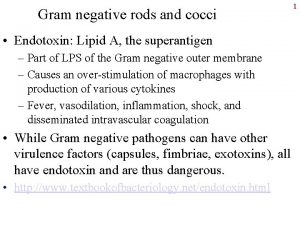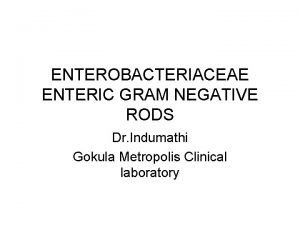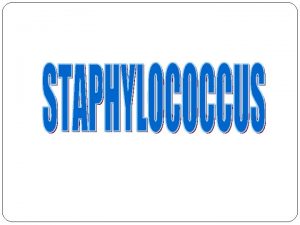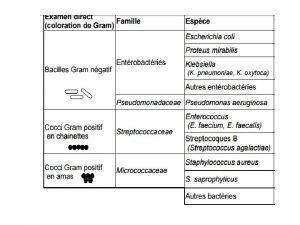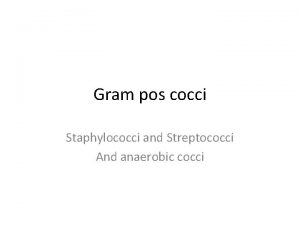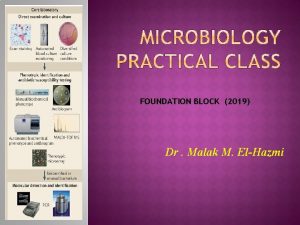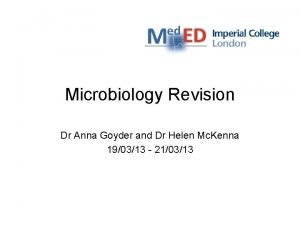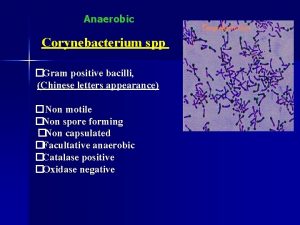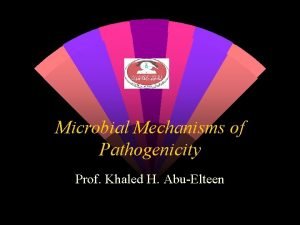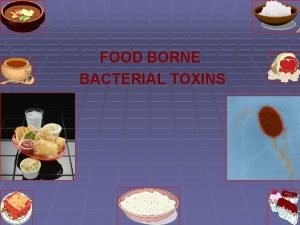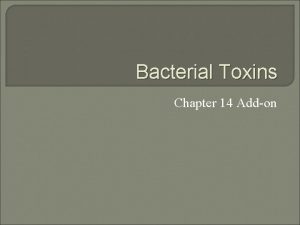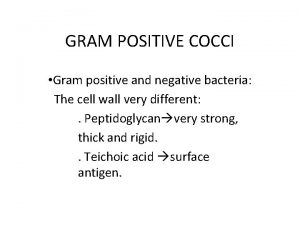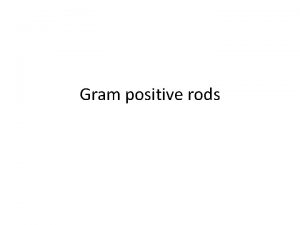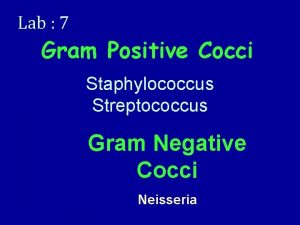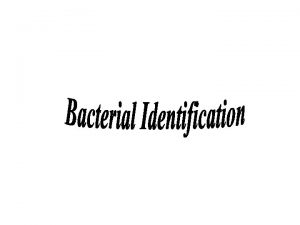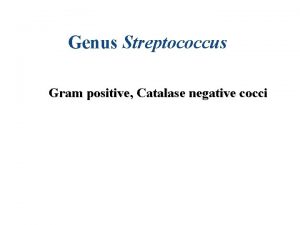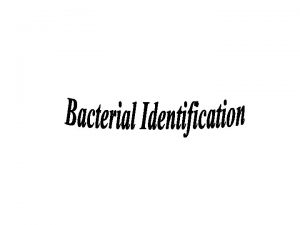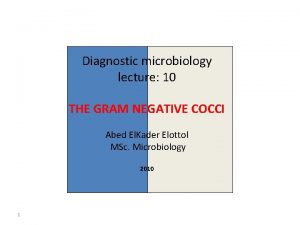Gram negative rods and cocci Endotoxin Lipid A
















- Slides: 16

Gram negative rods and cocci • Endotoxin: Lipid A, the superantigen – Part of LPS of the Gram negative outer membrane – Causes an over-stimulation of macrophages with production of various cytokines – Fever, vasodilation, inflammation, shock, and disseminated intravascular coagulation • While Gram negative pathogens can have other virulence factors (capsules, fimbriae, exotoxins), all have endotoxin and are thus dangerous. 1

Neisseria: Gram negative cocci • Very few G- cocci; these are pathogenic ones • N. meningitidis and N. gonorrhoeae. – Delicate and fastidious; – oxidase +, coffee bean shaped in pairs • N. gonorrhoeae: cause of gonorrhea, STD – Virulence factors: capsule, fimbriae, survival in neutrophils – Males: painful purulent discharge from urethra – Females: often asymptomatic; otherwise, urethritis, PID, infections anywhere sexual contact occurs, arthritis. – Eye infection of newborns, routine antibiotic treatment – No long term immunity! www. cat. cc. md. us/. . . / unit 1/shape/dkngon. html 2

Neisseria-2 • N. meningitidis: 1 cause of bacterial meningitis – Capsule protects cells during phagocytosis – Present as normal microbiota in 40% of population – Transmitted by droplets, close contact – Infection of meninges, sore throat, high fever, headache, stiff neck, vomiting, convulsions, petechiae; rapid. – Epidemiology: people living in close contact; military recruits currently vaccinated; because of outbreaks, push to vaccinate college students. 3

Enterobacteriaceae: Gram negative rods • Gram negative, small rods, facultatively anaerobic, oxidase negative; found in soil, water, and GI tracts – some strictly pathogens, others opportunists – Coliforms (ferment lactose) and non-coliforms • Virulence factors – Endotoxin, capsules, fimbriae, exotoxins, others. • Enteric bacteria identified by biochemical tests – Selective/differential media, IMVi. C tests, etc. – Strains identified by serological techniques 4

Serology and enteric bacteria • Because enteric bacteria are very closely related to each other, differentiation requires serology – Use of antibodies to identify particular antigenic molecules on cell surfaces – O antigen: repeating sugar group on LPS – H antigen: flagellar protein – K antigen: capsule antigen around cell. – Example: E. coli O 157: H 7 describes particular serotype which happens to also produce a dangerous exotoxin. 5

Some Opportunistic enterics 6 • E. coli: common cause of diarrhea, most common cause of urinary tract infections – Most strains common to GI tract, not harmful there. – Many strains possess plasmids that code for additional virulence factors like exotoxins which cause disease • E. coli O 157: H 7: possesses shiga toxin; strain causes hemolytic uremia syndrome, damages kidneys. • Klebsiella pneumoniae: various opportunistic infections including wound infections, pneumonia – Capsule is major virulence factor • Proteus: changes shape and flagella between liquid and solid media; common cause of urinary tract infections – Produces urease

Truly pathogenic enterics 7 • Salmonella: species so closely related that they are really all S. enterica. But medically, species epithets still used: S. typhi and others. Divided serologically. – Present in eggs, poultry, on animals such as reptiles – Large dose results in food poisoning; diarrhea, fever, etc. – Cells phagocytized by intestinal lining cells, kill cells, causing symptoms, may pass through into blood. – S. typhi: typhoid fever. Spread through body • Gall bladder as reservoir; Typhoid Mary • Importance of clean water and sewage treatment.

Truly pathogenic enterics-2 8 • Shigella: especially S. sonnei (most common) and S. dysenteriae (most serious); cause shigellosis. – Food, flies, fingers, feces, fomites: very small infectious dose, personal hygiene important in prevention. – Infection of intestinal lining damaged, cells pass directly from cell to cell; cramps, diarrhea, bloody stools. – S. dysenteriae produces shiga toxin which inhibits protein synthesis, increases damage. – Most serious problem with diarrheal diseases in general is dehydration.

Truly pathogenic enterics-3 9 • Yersinia: Y pestis is cause of plague, other species cause food-borne infections • Plague: 3 cycles: sylvan, urban, and human – endemic in sylvan cycle; mixing of woodland urban rodents brings urban cycle, fleas jump from dying rats to humans. – Infection leads to large swollen lymph nodes: buboes • Bubonic plague, with high fever. • Septicemic plague: with DIC, bruising (black death) – Raises mortality from 75% to near 100% • Pneumonic: coughed out and spread human to human – 100% mortality

The S. F. earthquake and plague http: //library. thinkquest. org/03 oct/00904/images/sanf. jpg http: //www. cdc. gov/ncidod/dvbid/plague/plagwest. htm 10

Pasteurellaceae: small G- rods • Oxidase + and fastidious • Pasteurella: mostly P. multocida – Common in animals; people get by bites, scratches – Inflammation, swollen nodes near site if infection • Haemophilus: H. influenzae and H. ducreyi – H. influenzae: mostly respiratory infections and meningitis and epiglottitis in very young. – Capsule is major virulence factor; Hib vaccine protects – H. ducreyi: STD chancroid; visible and painful in men. 11

Gram negative aerobic rods • Brucella: different species for each animal – Infection from contact with livestock, fluids incl dairy – Undulant fever: fever that goes up and down; several other names including Bang’s disease. • Bordetella: B. pertussis, cause of whooping cough – Infects trachea, several toxins. – Disease in stages: incubation, catarrhal, paroxysmal • Coughing and inhalation: whoop – DPT, but now new acellular vaccine due to publicity 12

Pseudomonas: G- aerobic rod • Pseudomonas and relatives very common • P. aeruginosa the most dangerous; opportunist – Endotoxin, exotoxins, fimbriae, enzymes, capsule – Capable of causing disease anywhere in body – Two major problems: burn patients and cystic fibrosis • Cause of swimmer’s ear, hot tub infections, etc. – Resistant to most disinfectants and antibiotics http: //www. wasserwissen. de/abwasserl exikon/p/images/pse udomonas. gif http: //www. readingfordummies. com/blog/archives/USPhotos/2005 -01 -12/01 -Hot. Tub. jpg 13

Other Gram - rods • Francisella: F. tularensis, cause of tularemia – Also called rabbit fever, tick fever, deerfly fever, etc. – Most cases in US in Arkansas/Missouri Ozarks – Survives phagocytosis, lives intracellularly – Present in many animals, transferred to humans by vector, ingestion, direct contact, inhalation – Chills, fever, malaise, swollen nodes http: //er 1. org/docs/photos/Tularemia/ Amblyomma%20 Americanum%20(lo ne%20 star%20 tick). jpg http: //mercury. bio. uaf. edu/~g eorge_happ/Francisella. jpg 14

Other Gram – rods-2 15 • Legionella: L. pneumophila and several others – Fastidious in culture, requires special media – Very common in aquatic environments: ponds, coolong towers, hotwater heaters, showers. – Grows normally in amoebae, so also grows in phagocytes – Most dangerous as opportunistic pneumonia, inhalation – Mild form of disease: ‘pontiac fever’ www. angelfire. com/. . . / bicentennial. html

Anaerobic Gram - rods 16 • Bacteroides – Many different anaerobic bacteria live in parts of body, esp. GI tract (>99% anaerobes) but also in mouth, genitourinary tract. – Trauma to these areas leads to polymicrobic inections. – In GI tract, a common bacterium is Bacteroides • Opportunist, causes abscesses in GI, reproductive, wound infections

